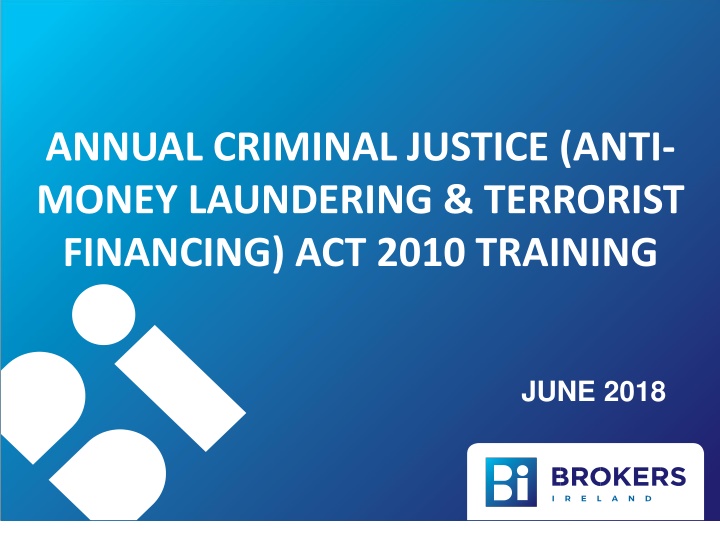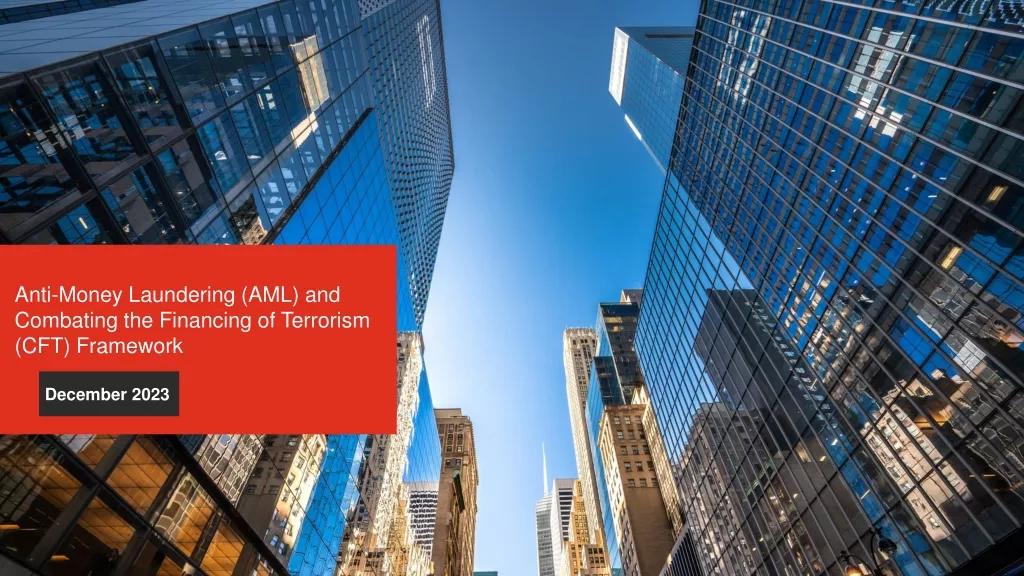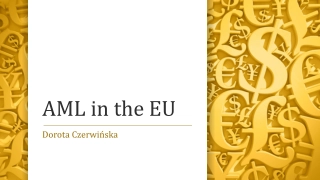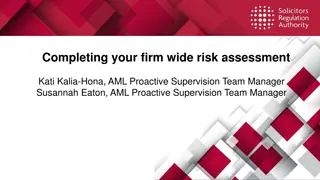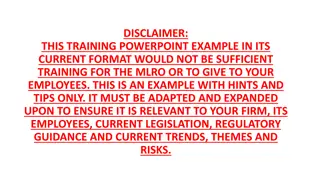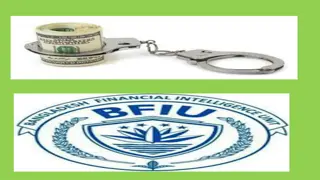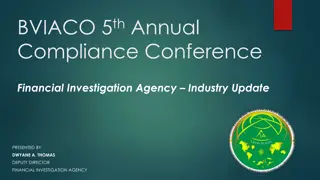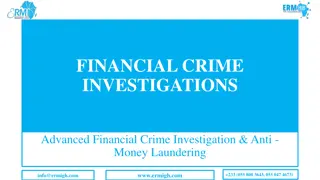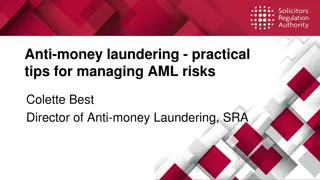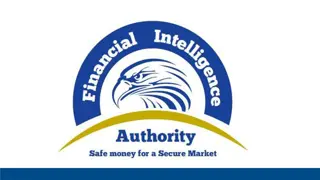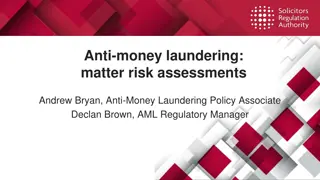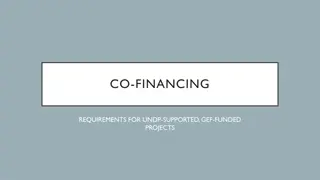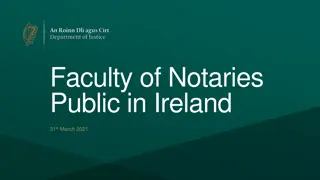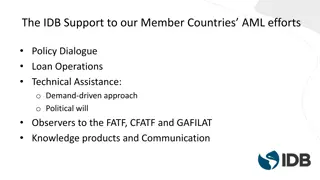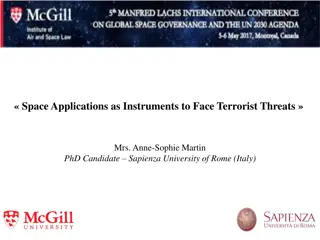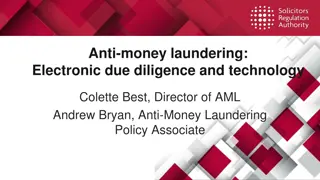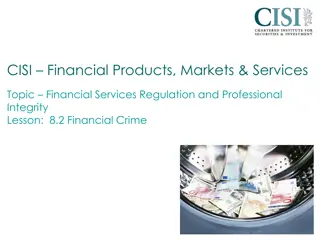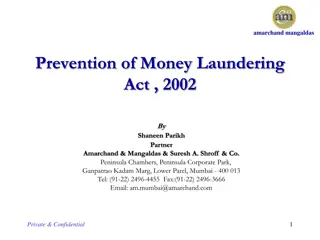Anti-Money Laundering & Terrorist Financing
Anti-Money Laundering & Terrorist Financing are processes used by criminals to hide the origins and ownership of illegal proceeds. This includes not only drug trafficking but also tax evasion, financial fraud, and theft. To combat these activities, designated persons must follow specified procedures and training to ensure compliance with the law.
Download Presentation

Please find below an Image/Link to download the presentation.
The content on the website is provided AS IS for your information and personal use only. It may not be sold, licensed, or shared on other websites without obtaining consent from the author.If you encounter any issues during the download, it is possible that the publisher has removed the file from their server.
You are allowed to download the files provided on this website for personal or commercial use, subject to the condition that they are used lawfully. All files are the property of their respective owners.
The content on the website is provided AS IS for your information and personal use only. It may not be sold, licensed, or shared on other websites without obtaining consent from the author.
E N D
Presentation Transcript
ANNUAL CRIMINAL JUSTICE (ANTI- MONEY LAUNDERING & TERRORIST FINANCING) ACT 2010 TRAINING JUNE 2018
What is Anti-Money Laundering & Terrorist financing? It is the process by which criminals conceal the true origin and ownership of the proceeds of drug trafficking or other criminal activity. A common misconception in relation to Money Laundering is that it only relates to theft, drug or similar offences. It might also be: Tax evasion Financial fraud and deception Theft
To be guilty of money laundering a person must know or believe the property involved is or probably is the proceeds of criminal conduct or be reckless as to whether the property is the proceeds of criminal conduct. Terrorist Financing Funds intended to finance an act of terrorism. Links between terrorist groups and organised criminal gangs. Includes converting, transferring, handling, acquiring, possessing or using the property that is the proceeds of criminal conduct. There must be intention or knowledge in providing or collecting funds for the purposes of financing terrorism, in order for there to be an offence. 3
Stages of Money Laundering There are three stages in the money laundering process: Placement this is the physical disposal of cash; Layering the creation of complex layers which make tracking transactions difficult; Integration absorbing the money back into the economy as legitimate money. 4
Designated Persons Mortgage Intermediaries and intermediaries by virtue of their registration as Insurance Intermediaries who provide Life Assurance or other investment related services are deemed to be DesignatedPersons . Note: Intermediaries only operating in the General Insurance market do not fall under the CDD requirements. 5
Designated Persons must have internal policies and procedures to reflect the requirements of the legislation in relation to the following areas: Customer due diligence Reporting Record keeping Internal procedures & training (All staff including executive & non-executive directors are required to receive training in relation to AML & combating terrorist financing.) 6
What does Customer Due Diligence mean? Identify & verify the customer. Identify & verify the beneficial owner (An individual who ultimately owns or controls the customer and/or on whose behalf a transaction or activity is conducted). Establish purpose & intended nature of business relationship (a business, professional or commercial relationship between the designated person and the customer that the designated person expects to be ongoing). Monitor customer dealings on an on-going basis.
Beneficial Owner Company An Individual holding 25% or more of shares or voting rights. Partnership An Individual holding 25% or more of profits or capital or voting rights, Trusts An individual with at least 25% of capital or has control over a trust. Estate Executor.
Purpose & intended nature of the business relationship In most cases this will be self evident e.g. Investing in a life policy Opening bank account Ongoing monitoring Scrutinise transactions: Source of wealth or funds Consistent with knowledge of customer and the customer s business and pattern of transactions
Customer Due Diligence Requirements Legislation allows designated persons to apply aspects of the customer due diligence requirements on a risk-sensitive basis depending on: a) b) product; c) d) The nature of the product being sold; The delivery mechanism or distribution channel used to sell the The profile of the customer; and The customer s geographical location and source of funds.
Intermediaries are required to carry out Customer Due Diligence Prior to establishing a business relationship with the customer. Prior to carrying out for/with the customer any transaction which appears linked to another transaction or prior to assisting the customer in carrying out a single transaction if: (i) You do not have a business relationship with the customer; and (ii) The total amount of money paid by the customer in the single transaction or series of transactions is greater than 15,000.
Intermediaries are required to carry out Customer Due Diligence (contd.) Prior to carrying out any service for the customer, if you have reasonable grounds to believe that there is a real risk that the customer is involved in money laundering/terrorist financing(ML/TF). If you have grounds to doubt the veracity of documents provided by the client.
Three categories of Customer Due Diligence (CDD) Simplified Customer Due Diligence applies to low risk customers and products. Enhanced Due Diligence applies to non-resident Politically Exposed Persons deemed to be high risk. Standard Due Diligence must be applied to all remaining customers and products.
Simplified Customer Due Diligence Simplified Customer Due Diligence (SCDD) means that a designated person does not need to comply with the CDD obligations (as listed previously). You must obtain sufficient information about the customer to satisfy that the customer meets the criteria for Simplified Due Diligence.
Simplified Customer Due Diligence: Specified Customers Banks and financial institutions in the State As they are themselves Designated Persons? A Company whose shares are listed A public body EU agencies and bodies
Simplified Customer Due Diligence: Specified Products Life assurance policy having an annual premium of no more than 1,000 or a single premium of no more than 2,500. Pension, superannuation or similar schemes which provide retirement benefits to employees; where contributions are made by an employer or by way of deduction from an employee s wages and the scheme rules do not permit the assignment of a member s interest under the scheme. Insurance policies for pension schemes if there is no surrender clause and the policy cannot be used as collateral (e.g.) Pension Term Assurance.
Enhanced Due Diligence In practice for intermediaries, Enhanced Due Diligence applies in respect of a business relationship or transaction with non resident Politically Exposed Persons (PEP s). A PEP is an individual who is not resident in Ireland and has been entrusted with prominent public functions or an immediate family member or a known close associate of such a person, who is not resident in Ireland. A person is a PEP if they held a relevant office at any time within the last 12 months
Enhanced Due Diligence contd. Designated persons must have processes in place prior to establishing a business relationship with a customer to determine whether the person may be deemed to be a PEP . Intermediaries should establish whether the client is resident or non resident. Where the client indicates that they are non resident, steps should be taken by the intermediary to establish if the customer falls within the definition of a PEP .
Enhanced Due Diligence contd. Require senior management approval to establish a business relationship with a PEP Take measures to establish the source of wealth and funds for transactions.
Standard Customer Due Diligence (SCDD) Applied on a risk based approach Profile of the customer Nature of product or service Distribution channel Geographical area of operation There are 3 overall levels of risk for insurance products: Low Risk Intermediate Risk Increased Risk
Standard Customer Due Diligence (Low Risk) There are products due to their inherent features which are unlikely to be used as a vehicle for money laundering purposes. These are classified as Low Risk . The following features would indicate low risk: Only pays out on death or diagnosis of terminal illness of policy holder. Only pays out on medical evidence and proof is required as to loss of income. No surrender value. Small, regular premiums: additional payments by customer not possible. Large premiums will normally require medical evidence. No investment element. Once term of policy is finished no payout and policy ceases.
Standard Customer Due Diligence (Low Risk) Examples of Products which fall into the low risk category are: Mortgage Protection, Term Life Assurance, Income protection products, Critical illness products (relating to diagnosis of a specific critical illness) and Whole of Life policies. For reduced risk level products, designated persons may accept personal cheques and other payment instruments drawn on a customer s account (i.e. Direct Debits/Standing Orders) to satisfy the standard evidence requirement. If payment is made by bankdraft for the products above, Brokers Ireland would recommend that you get confirmation from the client, from the bank, confirming where the money is coming from.
Standard Customer Due Diligence (Medium Risk) The medium risk level is given to products whose inherent features pose some risk for the purposes of money laundering or terrorist financing. These may be products which have a facility for topup payments. The following features would indicate medium risk: Long term savings plan often for retirement. Requires at least 5 years to gain positive return on investment. Often unable to be surrendered in first or second year, with penalties in years three to five. Additional top up payments may be permitted.
Standard Customer Due Diligence (Medium Risk) Examples of Medium risk products are : Life Assurance Savings plan (unless premium is less than 1,000 or 2,500, then Simplified Customer Due Diligence applies.) Endowments
Standard Customer Due Diligence (Medium Risk) The recommended standard for intermediate risk is as follows (subject to exemptions): Due diligence requirements are satisfied by the information collected on the application form, in conjunction with the fact that the payment is made from an account in the customer s name (i.e. personal cheques and other payment instruments drawn on a customer s account such as Direct Debits/Standing Orders). If payment is made by bank draft for the products referenced Brokers Ireland would recommend that you get confirmation from the client, from the bank, confirming where the money is coming from.
Standard Customer Due Diligence (High Risk) This level of risk has been given to products whose inherent features allow for the possibility of them being used for money laundering purposes. These products have the facility for third party and/or topup payments and therefore an enhanced level of due diligence, by asking for more information, is appropriate. This is the risk level that the majority of a designated person s AML resources will normally be directed. The majority of products in this range are found in the investment category which reflects the higher value premium that can be paid into them.
Standard Customer Due Diligence (High Risk) The following features would indicate High Risk: Open ended investment. Usually a 5 year recommended minimum investment term but can be surrendered earlier. Additional top up payments permitted by policy holder and by third parties. May be segmented and individual segments may be assignable.
Standard Customer Due Diligence (High Risk) Examples of High Risk products are: Single premium investment bonds including: With profits Guaranteed Income Investment Offshore international bonds
The recommended CDD industry standard for High Risk products is as follows: 1. Personal customers: Identification of a personal customer is the process whereby a designated person obtains from a customer the information necessary for it to identify who the customer is. The identity of an individual has a number of aspects at any point in time, all of which must be obtained by the designated person: 1) name (which may change due to particular events); 2) address (which is likely to change from time to time); and 3) date of birth (which is a constant).
One plus One approach Obtain one item from the list of photographic IDs (to verify name and date of birth) and one item from the list of non-photographic IDs (to verify address) at the outset of the business relationship. Sources which can be used to verify identity are: Current valid Passport. Current valid driving licence. Current valid National Identity Card. In the absence of the above documents, written or otherwise documented, assurances from persons or organisations that have dealt with the customer for some time may suffice. A designated person might consider it appropriate to adopt an alternative approach of identification such as seeking a social welfare card, National Immigration Bureau Card off an individual who has recently immigrated into the State.
Verify address Current official documentation/cards issued by the Revenue Commissioners. Current official documentation/cards issued by the Department of Social and Family Affairs. Instrument of a court appointment (such as liquidator or grant of probate). Current local authority document e.g. refuse collection bill. Current statement of account from a credit or financial institution. Current utility bills (including those printed from the internet). Current household/motor insurance certificate and renewal notice
Legal persons and arrangements Directors or the equivalent, for example: Partnerships and unincorporated businesses, Clubs, Societies, Public Sector bodies. Identification can generally be satisfied by either: obtaining a copy of the annual audited accounts listing directors (where the necessary information is publicly accessible and considered by the firm to be current and reliable); or Obtaining relevant and up-to-date legal opinion from a reliable source documenting due diligence conducted, in relation to information on directors: obtaining information from relevant company or other registry such as the CRO or known foreign equivalent; or as warranted by the risk, verify one or more directors in line with requirements for personal customers.
Legal persons and arrangements contd. To identify the legal arrangement: A search of the relevant company or other registry (where the necessary information is publicly accessible and considered by the firm to be current and reliable); or A copy, as appropriate to the nature of the entity, of the certificate of incorporation; a certificate of good standing; a partnership agreement; a deed of trust or other official documentation proving the name, form and current existence of the customer. In cases regarded by the firm as higher risk, use of more than one source of information may be warranted.
Legal persons and arrangements contd. 2. Acquire prescribed information at the outset of the business relationship to satisfy the additional information requirements: a) Source of funds for the transaction e.g. an Irish bank account in own name. b) Employment and salary details - this information could be captured in the Factfind. c) Source of wealth (e.g. inheritance, divorce settlement, property sale). This information should be captured on the source of wealth form.
Risk Assessment The firm must undertake and document a comprehensive risk assessment of the business, it should demonstrate that all potential Money Laundering/Terrorist Financing risks pertinent to their business have been fully considered and challenged such as : The nature of the products being sold in the firm The delivery mechanism or distribution channel used to sell the product The profile of the customer The customer s geographical location and source of funds The outcome of the risk assessment should inform the firm s risk-based approach and the design of AML/CTF controls. The firm s risk assessment should be subject to regular and scheduled reviews, senior management must at least on an annual basis review and approve this risk assessment.
Risk Assessment The firm must undertake and document a comprehensive risk assessment of the business, it should demonstrate that all potential Money Laundering/Terrorist Financing risks pertinent to their business have been fully considered and challenged such as : The nature of the products being sold in the firm The delivery mechanism or distribution channel used to sell the product The profile of the customer The customer s geographical location and source of funds The outcome of the risk assessment should inform the firm s risk-based approach and the design of AML/CTF controls. The firm s risk assessment should be subject to regular and scheduled reviews, senior management must at least on an annual basis review and approve this risk assessment.
Monitoring Ensure effective on-going monitoring policies and procedures are in place including full review and consideration of all trigger events. undertake monitoring on an ongoing basis for patterns of unusual or suspicious activity to ensure that higher risk activity is scrutinised. in practice, for intermediaries this might occur where there is an early surrender of a policy, encashment or where the payer of the policy changes.
Monitoring contd. Employees should be adequately trained to identify such unusual business and report to the designated person s Money Laundering Reporting Officer (MLRO) (insert firms MLRO name). For example, employee training should cover encashment fraud attempts with the recent increase in encashment requests being made from client emails to transfer funds to a particular account, where it transpired the client had no knowledge of the encashment request. Where an encashment request is received, it is recommended to take additional measures to ensure the request is genuine, for example: Phone the client to confirm the details/instruction Cross reference proof of ID and residency with existing proof of identity and residency on file
Distribution Risk may alter risk Face to Face contact with no facility to take copies of ID Where the interaction with the customer is on a face to face basis, you should have sight of the original document(s) and appropriate details should be recorded. Where you visit the customer at his/her home address, you should make a detailed record of the visit. This would include, for example, taking details of passport or driving license numbers. Brokers Ireland recommends that in such scenarios, you request the customer to forward you a copy of the relevant ID and cross reference it with the details which were recorded at the point of sale.
Distribution Risk may alter risk Non face-to-face The extent of the Customer Due Diligence in respect of non face-to-face customers will depend on the type of the product or service requested and the assessed money laundering risk presented by the customer. Where the customer is not physically present (e.g. by post, telephone or over the internet) for identification purposes additional measures should be undertaken to establish the customer s identity.
Distribution Risk may alter risk Examples: Telephone the customer on a home or business number which has been verified (electronically or otherwise). Communicate at a verified address with account opening docs for example, which might have to be returned or acknowledged . First payment by the customer through a bank in the State or other EU Member State or certain specified acceptable countries. Internet sign on with details sent by mail to a verified address.
Third Party Reliance Third Party Reliance A designated person is permitted to rely on another designated person to identify and verify its customers for AML purposes. Designated persons who rely on third parties will remain liable for any failure to comply not withstanding their reliance on the third party. The primary responsibility for supervising intermediaries lies with the Central Bank of Ireland, however Product Providers as a third party retains responsibility for ensuring that customer due diligence obligations have been met by the Intermediary. Note: Product Providers are legally obliged where an intermediary fails to meet the customer due diligence requirements to report this to the Central Bank of Ireland.
Third Party Reliance contd. In order to comply with the Third Party Reliance requirements, Product Providers depending on their internal processes may require either: Copies of all underlying documentary evidence from the Intermediary for applicable products. Or Confirmation of Verification of Identity, where the Product Provider has the right of audit to ensure that the intermediary has the necessary documentary evidence.
Failure to establish a customer and/or beneficial owners identity Where an intermediary can not establish the identity of a customer and/or beneficial owner, as a result of the failure of the customer to provide the designated person with documents of information required, then an intermediary must: Not provide a service to the customer, and If an existing customer, must discontinue relationship with the customer.
Procedures and Policies Senior Management are obliged to ensure that the firm has procedures and controls in place to demonstrate compliance with all aspects of the Act and approve them. Senior Management must have a clearly defined process in place for the formal review and approval, at least annually, of the policies and procedures at appropriate levels. Management must clearly set out all approved policies and procedures to enable staff to apply them in practice and ensure that all staff adhere to them. All procedures should be compliant with the Central Bank s core and sectoral guidance notes.
Procedures and Policies These internal policies and procedures should include: measures to be taken to keep documents and information relating to customers up to date. additional measures to be taken where there are reasonable grounds to believe that the circumstances relating to a customer, beneficial owner, service, product or transaction may present a heightened risk of money laundering or terrorist financing. The intermediary shall, in respect of that customer or beneficial owner, apply additional measures. measures to be taken to prevent the use of money laundering or terrorist financing of products/transactions that could favour or facilitate anonymity. monitor customers and transactions against both the EU and UN Sanctions Committee lists relating to terrorism.
Procedures and Policies This slide(s) should be personalised to outline the firms procedures and policies
Record Keeping Intermediaries are required to keep records evidencing the procedures applied and the information obtained, when carrying out CDD on customers for a period of at least 5 yrs after the business relationship with their customer has ended. (However, the Consumer Protection Code requires records to be kept for 6 yrs from date of last transaction with client.) Record keeping is an essential part of the evidence trail and sufficient processes must be put in place to ensure that records are adequately kept.
Record Keeping Customer information collected to comply with the requirements of Legislation; and Information regarding transactions undertaken by customers. Possible formats in which records can be retained include one or more of the following: Original documents Photocopies of original documents On microfiche In scanned form In computerised or electronic form
Record Keeping Intermediaries may keep such records wholly or partly in electronic form only if they are capable of being reproduced in a written form. All records should be capable of being reproduced in the State as per legislation for a period not less than 6 years. Outline the firms internal procedures in respect of record keeping here..
